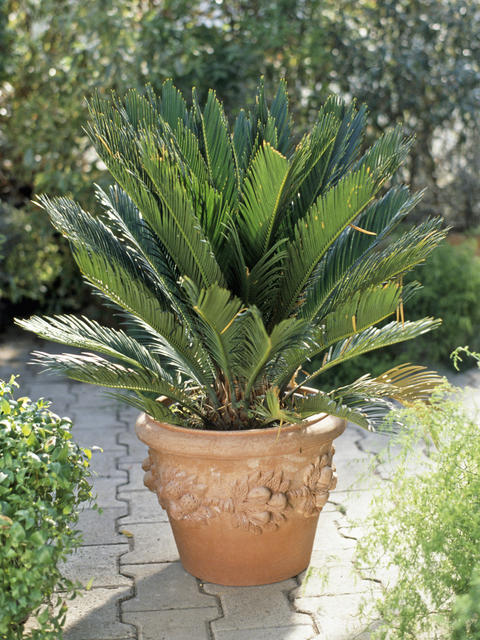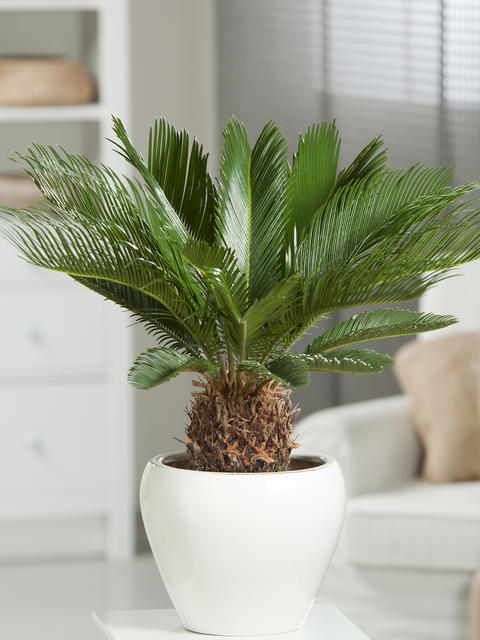Japanese sago palm, sago palm fern
The Japanese sago palm captures our attention with fern-like leaves and a palm-like trunk. Here’s how to plant and care for Cycas revoluta.
Factsheet
- Growth height (from)
- from 200 cm to 300 cm
- Growth characteristics
-
- upright
- overhanging
- Flower color
-
- yellow
- Flowering time (month)
-
- May to July
- Flower shape
-
- Cones
- Flower characteristics
-
- dioecious
- Leaf color
-
- green
- page format
-
- feathered
- narrow
- duster
- Sheet properties
-
- evergreen
- Fruit color
-
- orange
- red
- Light
-
- scattered light to semi-shade
- Soil type
-
- sandy to loamy
- Soil Moisture
-
- fresh to moderately humid
- ph value
-
- neutral to weakly acidic
- Lime compatibility
-
- lime-tolerant
- Nutrient requirements
-
- moderately nutritious
- Humus
-
- rich in humus
- Decorative or utility value
-
- Flower Decoration
- Leaf ornaments
- picturesque growth
- Toxicity
-
- toxic
- Climate zones according to USDA
-
- 10
- Use
-
- Interior greening
- Planters
- Winter garden
- Garden style
-
- Pot garden
The Japanese cycas (Cycas revoluta), also known as the Japanese sago palm, is native to Japan and South-east Asia. Botanically it belongs to the genus of the sago palm ferns (Cycas) within the Cycadaceae family. , which are also known as living fossils, are among the oldest plants in the world and grow relatively slowly. However, they can get very old and develop into imposing ornamental trees as they age. Cycas revoluta are of great horticultural importance: In the Mediterranean region, the species is often planted in gardens and parks, in our latitudes the Japanese cycad can be cultivated wonderfully as a houseplant or container plant.
In the first few years, the Cycas revoluta is quite slow in its growth; only later does it develop the short, thick and cylindrical stem. A new wreath of leaves grows from the trunk about every one to two years. Visually, the sago palm look like palm trees, but in other characteristics they are closer to ferns. In its natural habitat, the Japanese sago palm is usually around 9.84 feet high, and a height of 6.56 feet is also possible in a container. Caution: All parts of the sago palms are poisonous.
The large, simply pinnate fronds of the Japanese sago palmare deep green and leathery and grow to 1.64 to 6.56 feet long. They are composed of narrow, linear, very dense leaflets. The unfolding of the young leaves is interesting: Similar to young ferns, they are initially rolled up. In the case of the Japanese sago palm fern, they appear later rolled back at the edges - this is highlighted by the botanical species name "revoluta" (rolled back). At the base of the fronds, the leaflets gradually narrow until they appear thorny. The leaf stalks are slightly square shaped.

The flowers develop from May, but only in very oldJapanesesago palms. The plants are dioecious, which means that each plant only bears male or only female flowers. The male flowers look cone-shaped, the female flowers stand like a densely hairy, yellowish tuft in the middle of the leaf wreath. Even in the natural habitat, however, it is not always guaranteed that both sexes are close enough to be pollinated by the wind or insects.
Cycas revoluta belongs to the gymnosperm group, which means that the felt-like, hairy ovules are not enclosed by carpels. The seeds, which ripen from September to October, are orange to red in color.
Cycas revoluta loves a non-windy, warm and bright place. The light should come from all sides as far as possible, as is the case in a greenhouse or conservatory. If the outside temperature rises to an average of 20 degrees Celsius, the Japanese sago palms feels at home in a well-protected place outdoors. We recommend places in the light shade of trees or buildings, because the Japanese sago palm is a bit sensitive to direct sunlight. The temperature in its winter home should be around 59 degrees Fahrenheit.

For the sago palm sandy, permeable potting soil or cactus soil are suitable. Mixed in expanded clay also improves the substrate structure. The pH should be around six. In any case, ensure that the container plant has good drainage. Because palm ferns are quite sensitive to waterlogging.
Keep the soil moderately moist for the Japanese sago palm in summer . It is particularly important to ensure sufficient watering when the leaf fronds grow. However, longer dry phases are better tolerated than waterlogging. It is best to use rainwater or tap water with lowlime content for watering. Occasionally you can also spray water over sago palm. In winter it must be watered sparingly. As the temperatures drop, its water requirements reduce.
From April to September the Cycas revoluta must be fed a mild dose of liquid organic fertilizer every two weeks. The plant does not tolerate mineral fertilizers well. The plant must not be fertilized from October till new shoots are formed.
Since the Japanese sago palm grows quite slowly, repotting of the plant can be done at the most every three to four years. The best time for this is spring. The new pots or containers need not be much larger than the previous one.
Therefore, you should protect the long-lived old leaves and not cut them back heavily. Therefore, you should protect the long-lived old leaves and not cut them back heavily. Dead fronds usually fall off on their own, but can also be removed with a clean, sharp knife.

The Cycas revoluta must be placed in a bright spot during the winter months, at best in a conservatory or a greenhouse. The temperatures for the frost-sensitive plant should not fall below 50 to 59 degrees Fahrenheit. During this time, the Japanese sago palmmust be watered sparingly and should not be fertilized at all. The cycad must be acclimatized to the sun by gradually bringing it out in the sun.
A sowing of the Japanese sago palm is a long drawn process and not that easy. Since the seeds quickly lose their ability to germinate, they must be sown soon after they mature. A soil temperature of around 86 degrees Fahrenheit is important for germination. Choose a shady spot and keep the substrate moist until germination. Alternatively, Cycas revoluta can also be propagated using the stem tuber. These often form on old stems. They are separated and the cut surfaces are sprinkled with charcoal. They are then allowed to take root in soil at 68 degrees Fahrenheit.
Cycads are quite robust and there are hardly any plant diseases or pests. With the potted plants, however, you have to watch out for and scale insects. Brown leaves can indicate dry air or drought stress.

